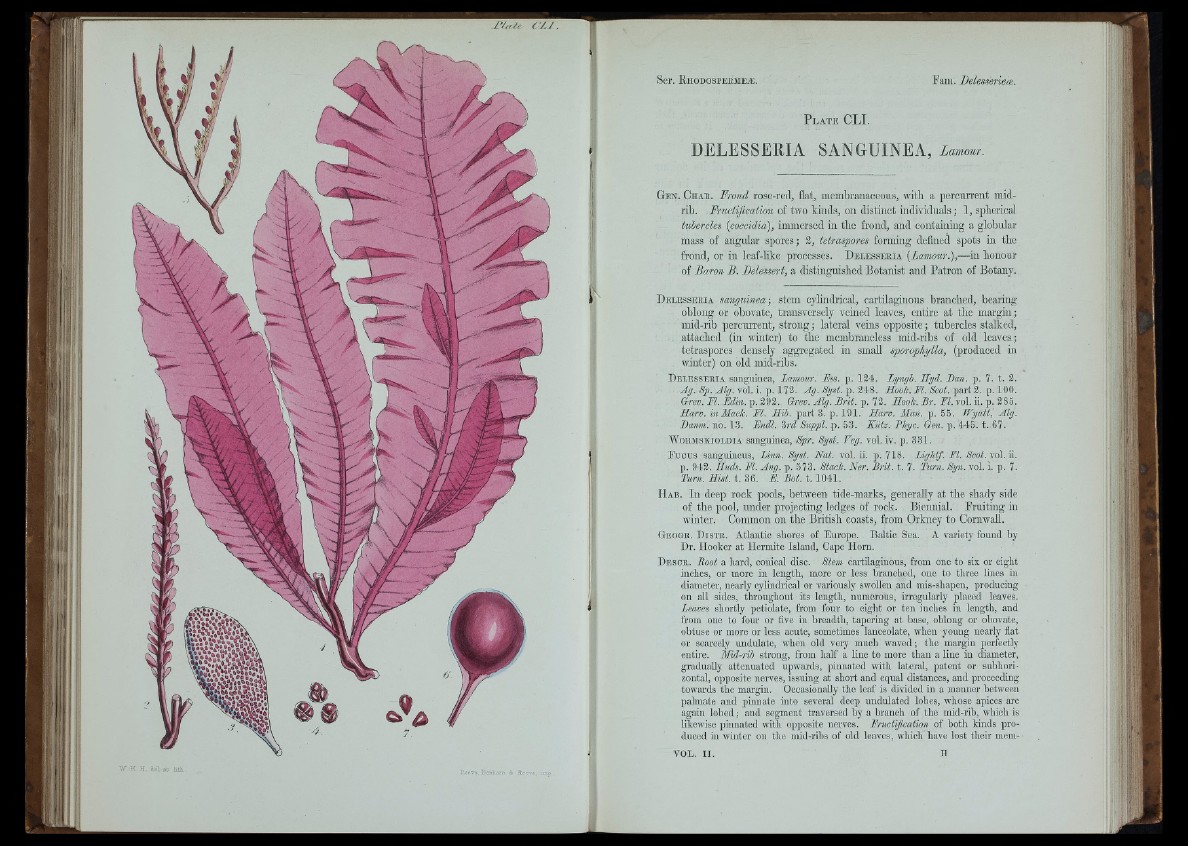
W K H. ael s t liti.. lU e v e , B e n h am & lU-exu
P l a t e CLI.
DELESSERIA SANGUINEA, Lamour.
G e n . Ch a r . Frond rose-red, flat, membranaceous, rvith a percuirent midrib.
Fructification of two kinds, on distinct individuals; 1, spherical
tuhercles [coccidia), immersed in the frond, and containing a globular
mass of angular spores; 2, tetraspores forming defined spots in the
frond, or in leaf-like processes. D e lesseria [Lamour.),—in honour
of Baron B . Delessert, a distinguished Botanist and Patron of Botany.
D e lesseria sanguimea-, stem oyhndiical, cartilaginous branched, bearing
oblong or obovate, transversely veined leaves, enth e a t the m argin;
mid-rib percuirent, strong ; lateral veins opposite ; tubercles stalked,
attached (in winter) to the membraneless mid-ribs of old leaves ;
tetraspores densely aggregated in small sporophjlla, (produced in
winter) on old mid-ribs.
De le sse r ia sanguinea, Lamour. Fss. p. 124. Lyngh. Hgd. Ban. p. 7. t. 2.
Ag. Sp. Alg. vol. i, p. 172. Ag. Syst. p. 248. Hook. FI. Scot. part 3, p. 100.
Grev. FI. Fdin. p. 293. Grev. Alg. Brit. p. 73. Hook. Br. FI. vol. ii. p. 385.
Harv. in Mack. FI. Hib. part 3. p. 191. Harv. Man. p. 55. Wyatt, Alg.
Banm. no. 13. Fndl. 3rd Suppl. p. 53. Kiitz. Phyc. Gen. p. 445. t. 67.
AVormskioldia sanguinea, Spr. Syst. Feg. vol. iv. p. 331.
F c cn s sanguineus, Linn. Syst. Nat. vol, ii. p. 718. Lightf. FI. Scot. vol. ii.
p. 943. Huds. FI. Ang. p. 573, Stack. Ner. Brit, t. 7- Turn. Syn. vol. i. p. 7.
». Hist. t. 36, F. Bot. 1 .1041.
H ab. In deep rock pools, between tide-marks, generally at the shady side
of the pool, under projecting ledges of rock. Biennial. Fruiting in
winter. Common on the British coasts, from Orkney to Cornwall.
G eogr. D ist r . Atlantic shores of Europe. Baltic Sea. A variety found by
Dr. Hooker at Hermite Island, Cape Horn.
D e sc r . Root a hard, conical disc. Stem cartilaginous, from one to six or eight
inches, or more in length, more or less branched, one to three lines in
diameter, nearly cylindrical or variously swollen and mis-shapen, producing
on all sides, throughout its length, numerous, irregularly placed leaves.
Leaves shortly petiolate, from four to eight or ten inches in length, and
from one to four or five in breadth, tapering at base, oblong or obovate,
obtuse or more or less acute, sometimes lanceolate, when young nearly flat
or scarcely undulate, when old very much waved; the margin perfectly
entire. Mid-rib strong, from half a line to more than a line in diameter,
gradually attenuated upwards, pinnated with lateral, patent or subhorizontal,
opposite nerves, issuing at short and equal distances, and proceeding
towards the margin. Occasionally the leaf is divided in a manner between
palmate and pinnate into several deep undulated lobes, whose apices are
again lobed; and segment traversed by a branch of the mid-rib, wliich is
likewise pinnated with opposite nerves. Fructification of both kinds produced
in winter on the mid-ribs of old leaves, which have lost their memi
I]
I tJ
F
.1